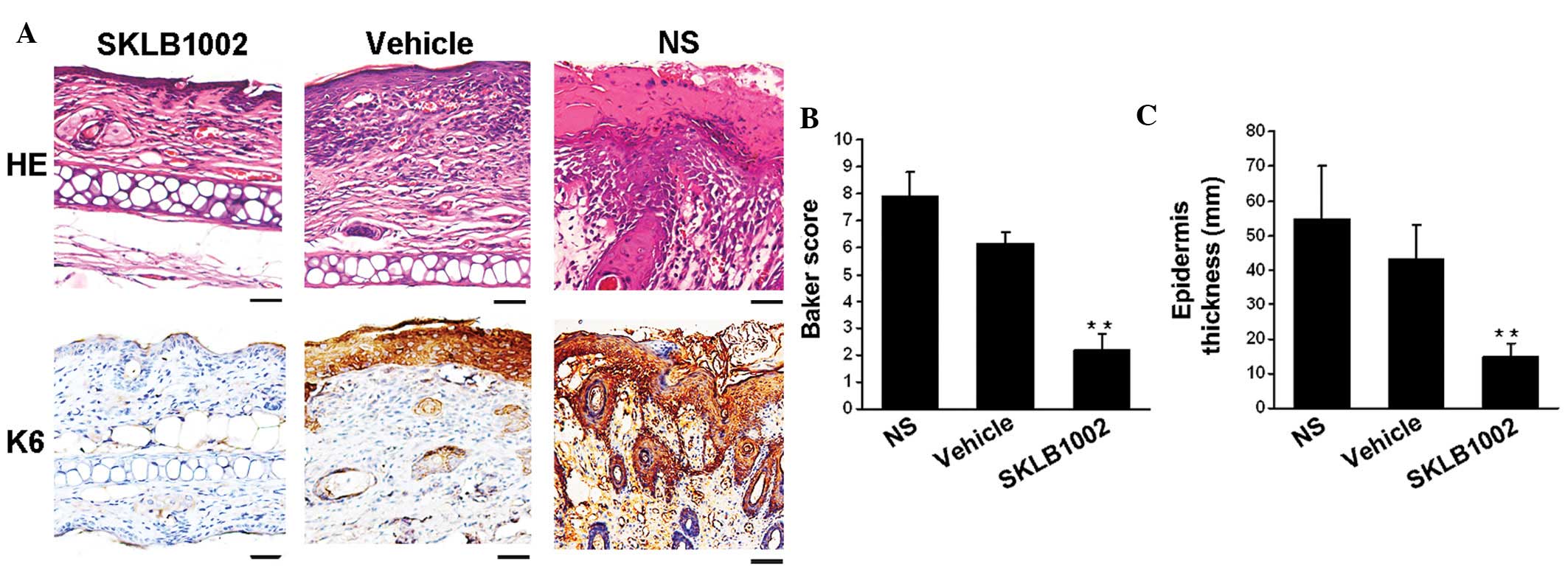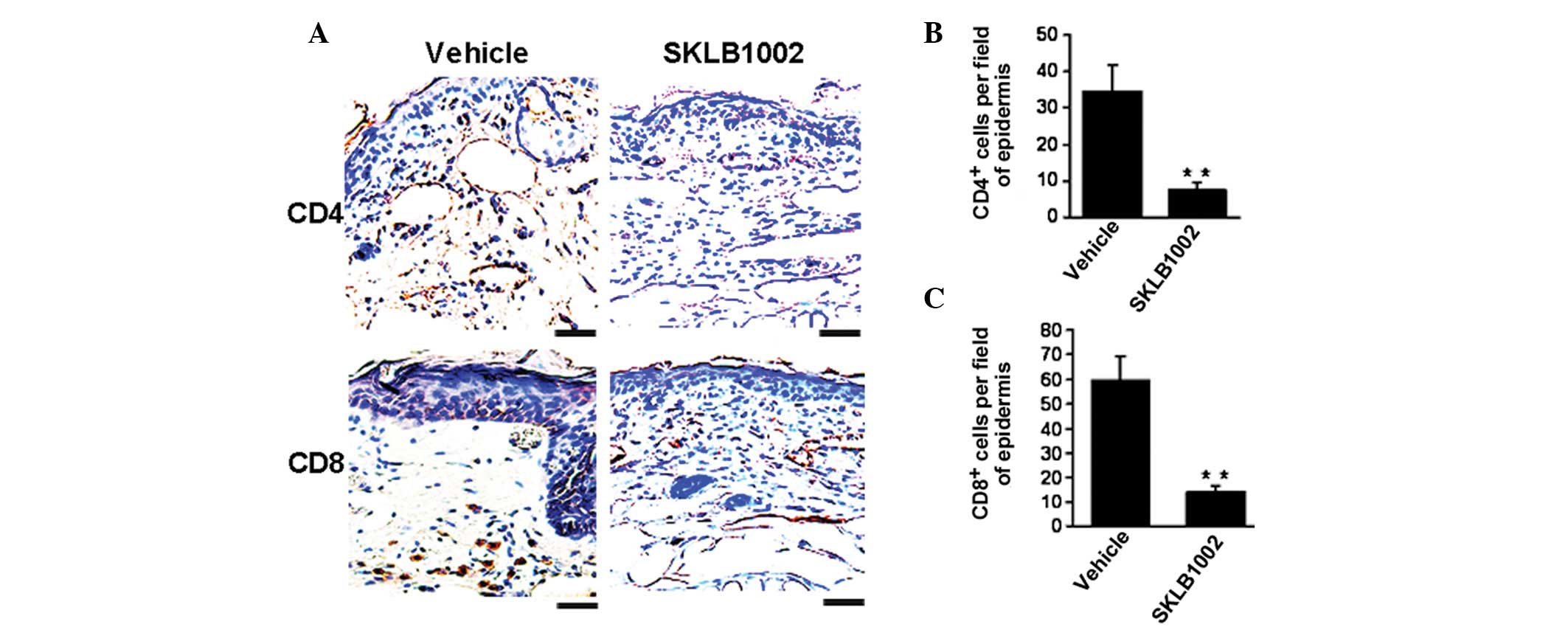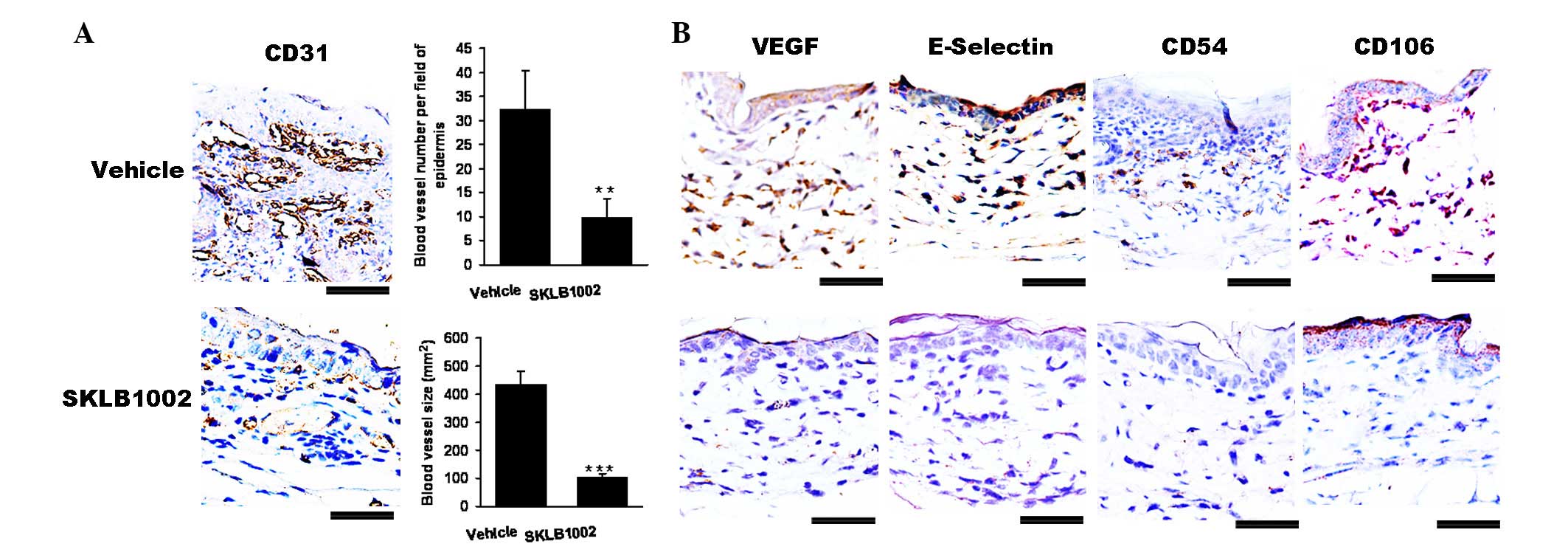|
1
|
Christensen TE, Callis KP, Papenfuss J, et
al: Observations of psoriasis in the absence of therapeutic
intervention identifies two unappreciated morphologic variants,
thin-plaque and thick-plaque psoriasis, and their associated
phenotypes. J Invest Dermatol. 126:2397–2403. 2006. View Article : Google Scholar
|
|
2
|
Bowcock AM and Krueger JG: Getting under
the skin: the immunogenetics of psoriasis. Nat Rev Immunol.
5:699–711. 2005. View
Article : Google Scholar : PubMed/NCBI
|
|
3
|
Creamer D, Allen MH, Sousa A, Poston R and
Barker JN: Localization of endothelial proliferation and
microvascular expansion in active plaque psoriasis. Br J Dermatol.
136:859–865. 1997. View Article : Google Scholar : PubMed/NCBI
|
|
4
|
Pinkus H and Mehregan AH: The primary
histologic lesion of seborrheic dermatitis and psoriasis. J Invest
Dermatol. 46:109–116. 1966.PubMed/NCBI
|
|
5
|
Liew SC, Das-Gupta E, Chakravarthi S, et
al: Differential expression of the angiogenesis growth factors in
psoriasis vulgaris. BMC Res Notes. 5:2012012. View Article : Google Scholar : PubMed/NCBI
|
|
6
|
Detmar M, Brown LF, Claffey KP, et al:
Overexpression of vascular permeability factor/vascular endothelial
growth factor and its receptors in psoriasis. J Exp Med.
180:1141–1146. 1994. View Article : Google Scholar : PubMed/NCBI
|
|
7
|
Flisiak I, Zaniewski P, Rogalska M,
Mysliwiec H, Jaroszewicz J and Chodynicka B: Effect of psoriasis
activity on VEGF and its soluble receptors concentrations in serum
and plaque scales. Cytokine. 52:225–229. 2010. View Article : Google Scholar : PubMed/NCBI
|
|
8
|
Cordiali-Fei P, Trento E, D’Agosto G, et
al: Effective therapy with anti-TNF-alpha in patients with
psoriatic arthritis is associated with decreased levels of
metalloproteinases and angiogenic cytokines in the sera and skin
lesions. Ann NY Acad Sci. 1110:578–589. 2007. View Article : Google Scholar : PubMed/NCBI
|
|
9
|
Nielsen HJ, Christensen IJ, Svendsen MN,
et al: Elevated plasma levels of vascular endothelial growth factor
and plasminogen activator inhibitor-1 decrease during improvement
of psoriasis. Inflamm Res. 51:563–567. 2002. View Article : Google Scholar
|
|
10
|
Detmar M: The role of VEGF and
thrombospondins in skin angiogenesis. J Dermatol Sci. 24(Suppl 1):
S78–S84. 2000. View Article : Google Scholar : PubMed/NCBI
|
|
11
|
Yano K, Kajiya K, Ishiwata M, Hong YK,
Miyakawa T and Detmar M: Ultraviolet B-induced skin angiogenesis is
associated with a switch in the balance of vascular endothelial
growth factor and thrombospondin-1 expression. J Invest Dermatol.
122:201–208. 2004. View Article : Google Scholar : PubMed/NCBI
|
|
12
|
Man XY, Yang XH, Cai SQ, Yao YG and Zheng
M: Immunolocalization and expression of vascular endothelial growth
factor receptors (VEGFRs) and neuropilins (NRPs) on keratinocytes
in human epidermis. Mol Med. 12:127–136. 2006.PubMed/NCBI
|
|
13
|
Elias PM, Arbiser J, Brown BE, et al:
Epidermal vascular endothelial growth factor production is required
for permeability barrier homeostasis, dermal angiogenesis, and the
development of epidermal hyperplasia: implications for the
pathogenesis of psoriasis. Am J Pathol. 173:689–699. 2008.
View Article : Google Scholar
|
|
14
|
Canavese M, Altruda F, Ruzicka T and
Schauber J: Vascular endothelial growth factor (VEGF) in the
pathogenesis of psoriasis - a possible target for novel therapies?
J Dermatol Sci. 58:171–176. 2010. View Article : Google Scholar : PubMed/NCBI
|
|
15
|
Cao Y: Opinion: emerging mechanisms of
tumour lymphangiogenesis and lymphatic metastasis. Nat Rev Cancer.
5:735–743. 2005. View
Article : Google Scholar : PubMed/NCBI
|
|
16
|
Zhang S, Cao Z, Tian H, et al: SKLB1002, a
novel potent inhibitor of VEGF receptor 2 signaling, inhibits
angiogenesis and tumor growth in vivo. Clin Cancer Res.
17:4439–4450. 2011. View Article : Google Scholar : PubMed/NCBI
|
|
17
|
Hedlund EM, Yang X, Zhang Y, et al: Tumor
cell-derived placental growth factor sensitizes antiangiogenic and
antitumor effects of anti-VEGF drugs. Proc Natl Acad Sci.
110:654–659. 2013. View Article : Google Scholar : PubMed/NCBI
|
|
18
|
Xia YP, Li B, Hylton D, Detmar M,
Yancopoulos GD and Rudge JS: Transgenic delivery of VEGF to mouse
skin leads to an inflammatory condition resembling human psoriasis.
Blood. 102:161–168. 2003. View Article : Google Scholar : PubMed/NCBI
|
|
19
|
Baker BS, Brent L, Valdimarsson H, et al:
Is epidermal cell proliferation in psoriatic skin grafts on nude
mice driven by T-cell derived cytokines? Br J Dermatol.
126:105–110. 1992. View Article : Google Scholar : PubMed/NCBI
|
|
20
|
Lowes MA, Chamian F, Abello MV, et al:
Increase in TNF-alpha and inducible nitric oxide
synthase-expressing dendritic cells in psoriasis and reduction with
efalizumab (anti-CD11a). Proc Natl Acad Sci USA. 102:19057–19062.
2005. View Article : Google Scholar : PubMed/NCBI
|
|
21
|
Schonthaler HB, Huggenberger R, Wculek SK,
Detmar M and Wagner EF: Systemic anti-VEGF treatment strongly
reduces skin inflammation in a mouse model of psoriasis. Proc Natl
Acad Sci USA. 106:21264–21269. 2009. View Article : Google Scholar : PubMed/NCBI
|
|
22
|
Ferrara N, Gerber HP and LeCouter J: The
biology of VEGF and its receptors. Nat Med. 9:669–676. 2003.
View Article : Google Scholar : PubMed/NCBI
|
|
23
|
Kunstfeld R, Hirakawa S, Hong YK, et al:
Induction of cutaneous delayed-type hypersensitivity reactions in
VEGF-A transgenic mice results in chronic skin inflammation
associated with persistent lymphatic hyperplasia. Blood.
104:1048–1057. 2004. View Article : Google Scholar : PubMed/NCBI
|
|
24
|
Dvorak HF, Brown LF, Detmar M and Dvorak
AM: Vascular permeability factor/vascular endothelial growth
factor, microvascular hyperpermeability, and angiogenesis. Am J
Pathol. 146:1029–1039. 1995.PubMed/NCBI
|
|
25
|
Detmar M, Brown LF, Schon MP, et al:
Increased microvascular density and enhanced leukocyte rolling and
adhesion in the skin of VEGF transgenic mice. J Invest Dermatol.
111:1–6. 1998. View Article : Google Scholar : PubMed/NCBI
|













